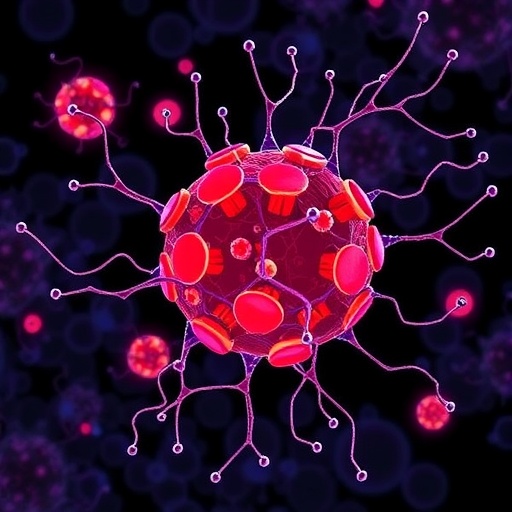In a groundbreaking study published in Nature, researchers have unveiled a compelling spatial coordination mechanism between lysosomes and the endoplasmic reticulum (ER) that orchestrates enhanced translation of secretome mRNAs. This intricate interplay, governed by the ER junction protein lunapark (LNPK), challenges long-standing perceptions of intracellular protein synthesis compartments and offers new insights into how cellular translation efficiency is optimized and compartmentalized within the cytoplasm.
The crux of the discovery lies in the identification of LNPK as a pivotal marker for specialized ER junctions that localize close to lysosomes. These LNPK-positive ER sites act as hubs where secretome mRNAs—those encoding proteins destined for secretion or membrane localization—are preferentially translated. The significance of this finding cannot be overstated, as it adds a new dimension to our understanding of secretory pathway regulation, linking translation dynamics to subcellular organelle organization in an unprecedented manner.
Using innovative reporter constructs termed cytERM-SunTag–MS2, the research team visualized actively translating secretome mRNA puncta within living cells. These puncta consistently congregated adjacent to lysosomes identified by fluorescently tagged LAMP1, a canonical lysosomal membrane marker. This spatial association was not random; rather, it coincided with an increase in the SunTag fluorescent signal intensity, indicative of a higher ribosome density on mRNAs near lysosomes. In essence, the proximity to lysosomes appeared to potentiate translational activity, suggesting that lysosomes might serve as a platform or microenvironment favoring efficient protein synthesis.
Importantly, the researchers distinguished translating from non-translating mRNA species by tracking mobility dynamics. They observed that SiT-EGFP–MS2 reporters exhibiting confined motion—consistent with active ribosome engagement and polysome formation—were significantly closer to lysosomes than their highly mobile, presumably untranslated counterparts. This further substantiates the notion that translation of secretome mRNAs is spatially organized at ER–lysosome interfaces, where molecular crowding and localized signaling could optimize the recruitment of translation machinery.
Delving deeper into the molecular players involved, the study illuminated the indispensable role of LNPK in establishing and maintaining this specialized ER–lysosome interface. In experiments where LNPK expression was knocked down, the previously observed elevation in ribosome density near lysosomes vanished. This striking loss of spatially restricted enhanced translation highlights LNPK’s function as a critical architectural scaffold that shapes the ER network to form conducive microdomains for secretome mRNA translation.
The implications of these findings extend into fundamental cell biology and the broader understanding of intracellular logistics. Traditionally, the ER has been viewed as a broadly distributed membrane network responsible for protein folding and trafficking, while lysosomes have been primarily associated with degradation and recycling. The discovery that lysosomes also play a direct role in modulating the translation of secreted proteins revolutionizes this view, positioning lysosomes as active participants in protein biogenesis rather than mere endpoints in lysosomal degradation pathways.
Moreover, these insights provoke intriguing questions about how metabolic states and lysosomal activity might dynamically regulate secretome production. Given that lysosomes serve as nutrient sensors and hubs for cellular signaling, their ability to influence translation at adjacent ER sites could represent a sophisticated feedback mechanism. It is conceivable that cells adapt secretome output in response to environmental cues by modulating ER–lysosome junction architecture through LNPK-mediated remodeling.
Technically, the study leverages state-of-the-art imaging methodologies that combine translation reporters with organelle-specific fluorescent markers, enabling real-time visualization of molecular events at unprecedented resolution. This methodological innovation provides a powerful platform to dissect the spatiotemporal dynamics of mRNA translation in physiologically relevant contexts, paving the way for future explorations into compartment-specific translation control.
From a translational research perspective, there are tantalizing prospects for exploiting the LNPK–lysosome axis to regulate secretory protein synthesis in pathological conditions. Aberrant secretome profiles underlie numerous diseases, including cancer, neurodegeneration, and immune disorders. Modulating ER–lysosome interfaces or LNPK function could emerge as a novel therapeutic strategy to fine-tune secretory pathways and restore cellular homeostasis.
Beyond secretome mRNA translation, the findings invite broader reevaluation of intracellular compartmentalization in gene expression regulation. It becomes apparent that cellular architecture is not merely a backdrop but an active determinant guiding where and when key biosynthetic processes occur. Such spatial dimension adds complexity but also opportunity for targeted cellular control mechanisms that have yet to be fully appreciated.
Intriguingly, this study sets the stage for dissecting how ribosome distribution and polysome dynamics integrate with membrane contact sites to sculpt protein synthesis landscapes. LNPK’s role as a nexus at ER junctions hints at a multiprotein complex that may coordinate membrane remodeling, ribosome recruitment, and mRNA localization—a hypothesis ripe for future molecular characterization.
As the field moves forward, it will be essential to elucidate the precise molecular underpinnings by which lysosomes facilitate enhanced ribosome loading on secretome mRNAs. Potential mechanisms might involve localized signaling cascades, lipid microdomain compositions, or protein-protein interactions that stabilize translating ribosomes at these ER subdomains. Understanding these will deepen our grasp on translational regulation in subcellular contexts.
In sum, this pioneering work uncovers a novel paradigm wherein the ER and lysosome collaborate via LNPK-marked junctions to spatially orchestrate secretome mRNA translation. By illuminating this sophisticated level of cellular organization, the study not only pushes the frontiers of cell biology but also opens exciting vistas for biomedical innovation targeting the secretory machinery.
Subject of Research:
The spatial regulation of secretome mRNA translation by lysosomes and lunapark-marked endoplasmic reticulum junctions.
Article Title:
Secretome translation shaped by lysosomes and lunapark-marked ER junctions
Article References:
Choi, H., Liao, YC., Yoon, Y.J. et al. Secretome translation shaped by lysosomes and lunapark-marked ER junctions. Nature (2025). https://doi.org/10.1038/s41586-025-09718-0
Image Credits:
AI Generated




